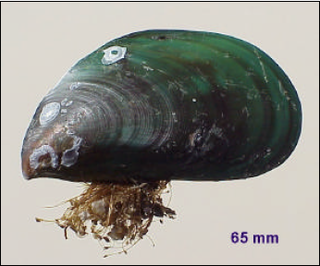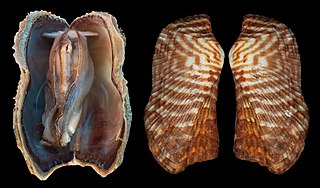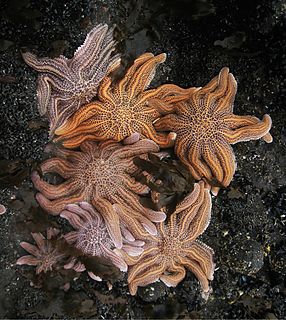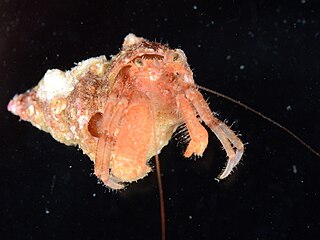
Tide pools or rock pools are shallow pools of seawater that form on the rocky intertidal shore. Many of these pools exist as separate bodies of water only at low tide.
Fragmentation in multicellular or colonial organisms is a form of asexual reproduction or cloning, where an organism is split into fragments. Each of these fragments develop into mature, fully grown individuals that are clones of the original organism.
Prymnesium parvum is a species of haptophytes. The species is of concern because of its ability to produce the phycotoxin prymnesin. It is a flagellated alga that is normally found suspended in the water column. It was first identified in North America in 1985, but is not known if it was introduced artificially. Toxin production mainly kills fish and appears to have little effect on cattle or humans. This distinguishes it from a red tide, which is an algal bloom whose toxins lead to harmful effects in people. Although no harmful effects are known, it is recommended not to consume dead or dying fish exposed to a P. parvum bloom. P. parvum of Haptophyta is sometimes classified as a golden algae or a golden brown algae, as is Chrysophyceae of Heterokontophyta, but the taxonomy of algae is under complex revision, leading to contradictions in terms, especially in non-scholarly texts.

Perna viridis, known as the Asian green mussel, is an economically important mussel, a bivalve belonging to the family Mytilidae. It is harvested for food but is also known to harbor toxins and cause damage to submerged structures such as drainage pipes. It is native in the Asia-Pacific region but has been introduced in the Caribbean, and in the waters around Japan, North America, and South America.

Flabellina affinis is a species of sea slug, an aeolid nudibranch, a marine gastropod mollusk in the family Flabellinidae.

The white-edged nudibranch, Fjordia capensis, is a species of sea slug, specifically an aeolid nudibranch, a very colourful sea slug. It is a marine gastropod mollusc in the family Flabellinidae.
Oligophagy refers to the eating of only a few specific foods. The term is usually associated with insect dietary behaviour. Organisms may exhibit narrow or specific oligophagy where the diet is restricted to a very few foods or broad oligophagy where the organism feeds on a wide variety of specific foods but none other.

Mithrax spinosissimus, also known as the West Indian spider crab, channel clinging crab, reef or spiny spider crab, or coral crab, is a species of spider crab that occurs throughout South Florida and across the Caribbean Islands. The diet of this crab is largely unknown; however, it is considered a large omnivore, reaching size up to 2 kg, which has been noted to feed on algae and carrion. Unlike crabs such as the blue crab, the West Indian spider crab is not commercially harvested for its meat, though it is said to be delicious.

Arca zebra, or the turkey wing ark clam, is a bivalve mollusc in the family Arcidae, the ark clams.

Stichaster australis, the reef starfish, is a species of starfish found in the shallow waters of the rocky intertidal of New Zealand. Typically, the animal is endemic to the west coast shores of the North and South Islands, where wave action is increased. They do not usually inhabit ecosystems that have reduced wave action and calm conditions as they prefer a higher-energy environment. These marine invertebrates range in color from pink to purple, but can also be orange. They typically have eleven arms, but sometimes they may have either ten or twelve. As full-grown adults, they are 8 to 10 cm in diameter.
Pterygophora californica is a large species of kelp, commonly known as stalked kelp. It is the only species in its genus Pterygophora. It grows in shallow water on the Pacific coast of North America where it forms part of a biodiverse community in a "kelp forest". It is sometimes also referred to as woody-stemmed kelp, walking kelp, or winged kelp.

Paraflabellina ischitana is a species of sea slug, an aeolid nudibranch, a marine gastropod mollusk in the family Flabellinidae.

Eudendrium is a large genus of hydroids (Hydrozoa), one of two in the family Eudendriidae. These animals are marine cnidarias in the family Eudendriidae.
Eudendrium angustum is a marine species of cnidaria, a hydroid (Hydrozoa) in the family Eudendriidae.

Eudendrium ramosum, sometimes known as the tree hydroid, is a marine species of cnidaria, a hydroid (Hydrozoa) in the family Eudendriidae of the order Anthoathecata.

Calmella cavolini is a small aeolid, with a maximum length of 12mm. It has smooth elongate rhinophores, oral tentacles, and angular anterior foot corners. Cerata, with a common stalk each, are arranged in groups. The front 3 ceratal clusters, which are on each side, are oppositely arranged but the posterior 3 ceratal clusters are arranged alternately. The color of digestive gland duct is bright red but the apical cnidosac is white in color. The jaw plates are purplish red and they show through each side of the slug's head as a reddish color spot. It was reported that it feeds on the hydroid, Eudendrium.

A corallivore is an animal that feeds on coral. Corallivores are an important group of reef organism because they can influence coral abundance, distribution, and community structure. Corallivores feed on coral using a variety of unique adaptations and strategies. Animals known to be corallivores include certain mollusks, annelids, fish, crustaceans, flatworms and echinoderms. The first recorded evidence of corallivory was presented by Charles Darwin in 1842 during his voyage on HMS Beagle in which he found coral in the stomach of two Scarus parrotfish.

Obelia dichotoma is a broadly distributed, mainly marine but sometimes freshwater, colonial hydrozoan in the order Leptothecata that forms regular branching stems and a distinctive hydrotheca. O. dichotoma can be found in climates from the arctic to the tropics in protected waters such as marches and creeks but not near open coasts like beaches in depths up to 250m. O. dichotoma uses asexual and sexual reproduction and feeds on mainly zooplankton and fecal pellets. Obelia dichotoma has a complex relationship with the ecosystem and many economic systems.

Pagurus dalli, commonly known as the whiteknee hermit, is a species of hermit crab in the family Paguridae. It is found in the northeastern Pacific Ocean at depths down to about 276 m (900 ft). It usually lives in a mutualistic symbiosis with a sponge, or sometimes a hydroid.













